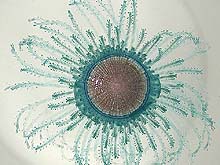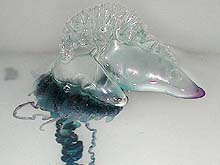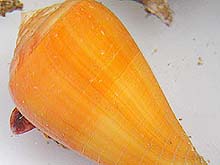
Porpita porpita has a small disc like body and floats freely in the water column. Related to the jellyfish, this species measures just one inch in diameter. Click image for a larger view.
What’s in a Name?
August 15, 2002
![]() During a dive at a site known as The Steeples, the submersible crew has a closeup encounter with a large moray eel. (mp4, 1 MB).
During a dive at a site known as The Steeples, the submersible crew has a closeup encounter with a large moray eel. (mp4, 1 MB).
![]() Watch a video of a beautiful hogfish as it swims by the Johnson-Sea-Link. (mp4, 1 MB).
Watch a video of a beautiful hogfish as it swims by the Johnson-Sea-Link. (mp4, 1 MB).
Liz Baird, Co-Principal Investigator
Islands in the Stream 2002 Outer Shelf and Slope Project
We wait for the return of every sub dive and every net like children waiting for Christmas morning. We can’t wait to see what “special packages” have been brought from the deep. Will it be something we have been looking for or will it be something new? As we sort through the material brought to the deck there is a constant refrain – “What is this?”
There are two types of names used to help us identify organisms. There is the common name, which usually refers to a distinguishing characteristic. A “Slime Nose” has a mucous covered gelatinous blob on its nose. The “Two Spot Cardinalfish” is bright red with two dark spots on its back. The “Flying Gurnard” has very long fins that stretch out and look like wings as it skims over the bottom of the sea. Common names usually provide clues about the animal’s appearance or behavior. Unfortunately common names are not very specific, and one name may often be used for different animals in different regions. For instance in some regions people call “Largemouth Bass” a “Trout.” This can be very confusing.

This tiny and very dangerous Portugese Man-O-War jellyfish was collected during one evening’s “night-lighting” samplings. Click image for a larger view.
The other type of name we use is the scientific name. Scientific names are important to help identify what we find and to avoid confusion. The scientific name has two parts. The first part is the genus and the second is the species. Humans are called Homo sapiens. “Homo” means man and “sapiens” means wise, so we are the group of “wise men.” Each species of plant or animal has a particular scientific name. Scientific names are the same around the world. No matter where you go, if you use the word “Homo sapiens” people know that you are talking about humans.
Scientific names have a tendency to look a bit like “gobbledy-gook” when first encountered. However both the genus and species names generally describe something about the organism using Latin or Greek root words. For example one of the common dinoflagellates (unique one-celled plants which move via two whip-like appendages) that causes bioluminescence is called Noctiluca, which means “night light.” Another is called Pyrodinim, which means, “fire whirler.” Both scientific names suggest the amazing behavior of these microorganisms. Humpback whales have a common name which describes a behavior (they hump their back as they dive). Their scientific name Megaptera novaeangliae “White-winged New Englander” describes their large light-colored fins and where they were frequently seen. Some scientific names come from the vessel that was used to find them. There are several deep-water species that have a variation of the name “Alvin” since, they were discovered by scientists using the Alvin submersible. Of course organisms are also named after scientists although it is considered “bad form” to name a new species after yourself.

This cone shell was collected during an invertebrate “sweep” of the ocean floor using the JSL II’s suction sampler. It’s beautiful colors are reminiscent of tropical Indo-Pacific species. Click image for a larger view.
During our dive on the afternoon of August 13th we were privileged to see more than 60 species of fish. I struggled to keep up with the list of common names as scientist Fritz Rohde called them from the bow – “hogfish” “jack” “doctorfish.” My hand records the names as my mind wonders why in the world it is called a “doctorfish?” There are also familiar names from trips to the Caribbean such as “butterflyfish” which, as its name suggests, is brightly colored and appears to flit over the coral heads.
Luckily I did not have to record scientific names from my small space in the stern of the Johnson Sea-Link. Instead I copied the list of scientific names that Fritz made when we returned to the Seward Johnson. Some of the meanings of the scientific names are blatantly obvious such as Chromis cyanea, which is the name for an incredibly shiny blue fish. Dactylopterus volitans is the “Flying Gurnard.” I can guess that the “dactyl” part of the scientific name means wing like the “Pterodactyls” of the dinosaurian world. Other names will require more study such as the “Lutjanus buccanella” which is commonly called the Blackfin Snapper. I long for a dictionary of scientific names but it is not available on board.

This tiny spiny puffer fish was caught in one of our recent neuston net tows. Click image for a larger view.
We brought a few “gifts” up from our dive. As usual we wanted to put a name on what we had found. There was a “Soapfish” with slimy skin which “foams up” when rubbed. We also brought up an unusual scallop shell with lots of spines that will require more study before it can be named. Other nets brought in “Porpida” which are interesting blue jellyfish-like creatures with long blue tentacles. We caught a “halfbeak” in a dipnet. Its lower beak is much longer than its upper beak. Its genus name is Hyporhamphus and I guess the meaning is “lower jaw” which matches its appearance,
We will try to identify all of the players that make up these unique habitats. Only by identifying the kinds and numbers of organisms that are in these areas can we detect how the species that live in a habitat change over time, and more importantly, begin to understand what may be causing that change. We will record their scientific names when we get back to the lab and can confirm their identities. Who knows if we will have the species we expect to find or if we have found something new? Until then we will continue to await the arrival of the next samples and videos and continue to ask, “What is it?”
Sign up for the Ocean Explorer E-mail Update List.














































